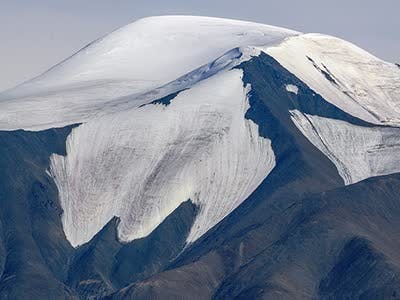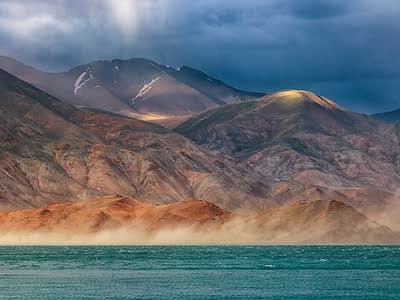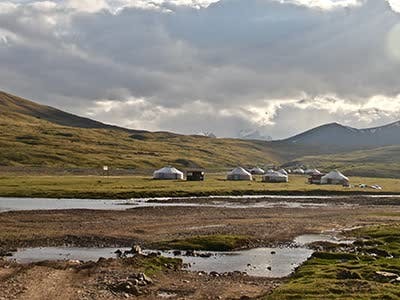Altai Tavan Bogd National Park
ABOUT ALTAI TAVAN BOGD NATIONAL PARK
Altai Tavan Bogd National Park is a protected area located in the western part of Mongolia, near the border with Russia and China. Here's some information about Altai Tavan Bogd National Park:
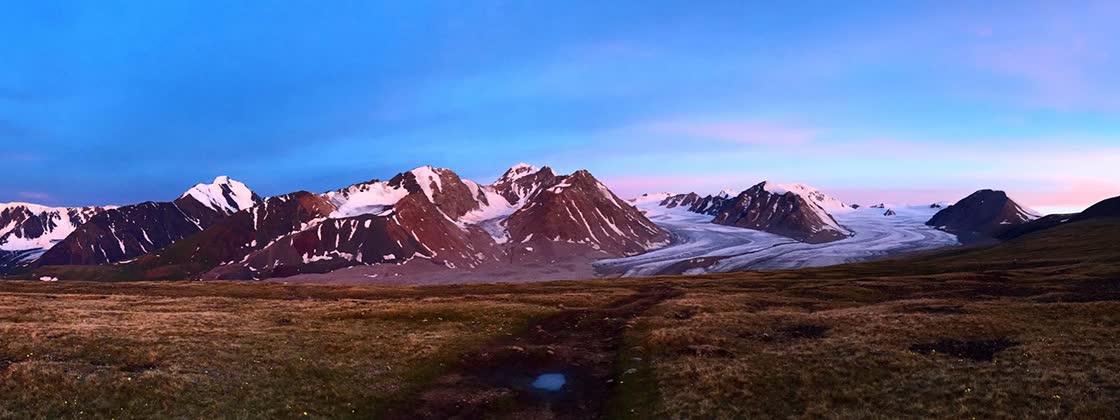
Altai Tavan Bogd National Park offers a blend of stunning natural landscapes, biodiversity, and cultural richness. It is a destination that appeals to nature lovers, outdoor enthusiasts, and those interested in experiencing the traditional lifestyles and customs of the Kazakh people.
Location and Landscape: Altai Tavan Bogd National Park is situated in the Bayan-Ölgii Province of Mongolia. It encompasses a diverse range of landscapes, including high mountains, glaciers, alpine meadows, deep valleys, and rivers. The park is named after its most prominent peaks, known as the Five Holy Peaks or Tavan Bogd, with Khuiten Peak being the highest at 4,374 meters (14,350 feet).
Biodiversity: The national park is known for its rich biodiversity and is home to a variety of plant and animal species. The park's diverse habitats support a range of wildlife, including endangered species such as the snow leopard, Altai argali (mountain sheep), Siberian ibex, and bearded vulture. The park also contains several alpine lakes and serves as an important habitat for migratory birds.
Cultural Heritage: Altai Tavan Bogd National Park is not only renowned for its natural beauty but also for its cultural significance. The park is located in an area inhabited by the Kazakh ethnic group, known for their traditional nomadic lifestyle and eagle hunting practices. Visitors to the park have the opportunity to experience the rich cultural heritage of the Kazakh people and witness their traditional customs and practices.
Outdoor Activities: Altai Tavan Bogd National Park offers various outdoor activities for visitors to enjoy. Trekking and mountaineering are popular pursuits, providing opportunities to explore the stunning mountainous landscapes, glaciers, and valleys. Horseback riding and camping are also popular activities, allowing visitors to immerse themselves in the natural beauty of the park.
Petroglyphs and Archaeological Sites: The park is known for its archaeological sites and rock art, including petroglyphs (ancient rock carvings) that provide insights into the region's past civilizations. These archaeological sites offer a glimpse into the ancient cultures and traditions of the area and are of great historical and cultural significance.
Conservation and Protection: Altai Tavan Bogd National Park is protected to preserve its unique natural and cultural heritage. Conservation efforts aim to safeguard the park's biodiversity, including the endangered species that inhabit the area. Sustainable tourism practices are encouraged to minimize the impact on the environment and ensure the long-term preservation of the park.
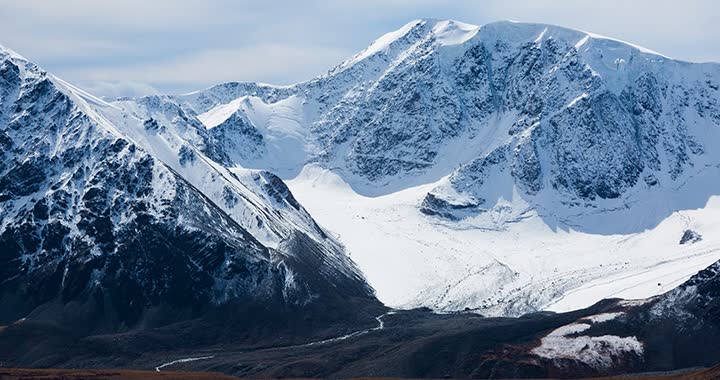
PEAKS
- KHUITEN PEAK /4374M/
- NAIRAMDAL PEAK /4180M/
- BURGED PEAK /4068M/
- ULGII PEAK /4050M/
- MALCHIN PEAK /4050M/
POTANIN GLACIER
Potanin Glacier is a remarkable natural feature in Mongolia's Altai Mountains, showcasing the beauty and power of glacial landscapes. Its accessibility within the Altai Tavan Bogd National Park offers opportunities for adventure, exploration, and scientific study, making it a significant destination for those interested in nature, outdoor activities, and environmental research.
- Location: Potanin Glacier is situated in the Bayan-Ölgii Province of western Mongolia. It is part of the Altai Tavan Bogd National Park and is surrounded by breathtaking mountain peaks, including the Tavan Bogd massif.
- Size: Potanin Glacier spans an area of approximately 14 square kilometers (5.4 square miles) and is one of the longest and most extensive glaciers in Mongolia. It is fed by snow and ice accumulation from the surrounding mountains and forms the headwaters of several rivers and streams.
- Altitude and Climate: The glacier is located at high altitude, with its lower parts situated around 3,000 meters (9,800 feet) above sea level. The climate in the region is characterized by cold winters and cool summers, with temperatures dropping well below freezing during the winter months. The glacier is covered by snow and ice throughout the year.
- Glacial Features: Potanin Glacier exhibits typical glacial features, including crevasses, icefalls, and seracs. It is a dynamic and ever-changing landscape due to the movement of the ice. The glacier flows slowly downhill, carving valleys and shaping the surrounding terrain over thousands of years.
- Hiking and Mountaineering: Potanin Glacier is a popular destination for outdoor enthusiasts, hikers, and mountaineers. The surrounding area offers stunning alpine scenery and challenging terrain for experienced climbers. Visitors can embark on treks and expeditions to explore the glacier and its surroundings, enjoying panoramic views of the Altai Mountains.
- Scientific Research: The glacier is of scientific interest and attracts researchers and scientists studying glaciology, climate change, and environmental processes. Studying the Potanin Glacier provides valuable insights into the effects of climate change on glaciers and their contribution to regional water resources.
WHITE RIVER VALLEY
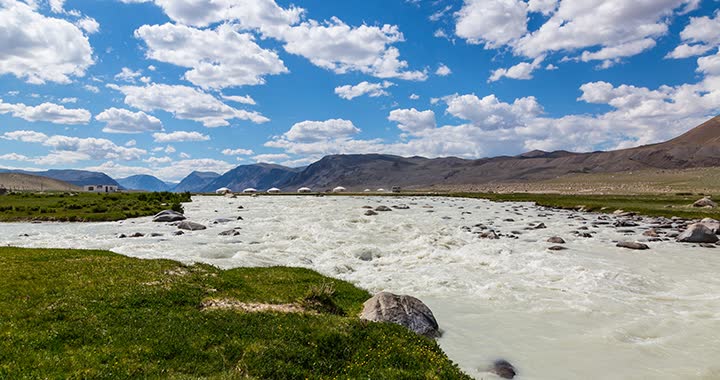
The White River Valley within Altai Tavan Bogd National Park offers a unique combination of stunning natural beauty, rich biodiversity, and cultural heritage. Whether it's hiking through the lush meadows, spotting wildlife, or simply immersing oneself in the serene surroundings, the valley provides a memorable and awe-inspiring experience for nature lovers and adventurers alike.
BAGA OIGOR PETROGLYPHS
The Baga Oigor Petroglyphs, also known as Baga Oygor Rock Art, are a collection of ancient rock carvings located in Mongolia. Here's some information about the Baga Oigor Petroglyphs:

- Location: The Baga Oigor Petroglyphs are situated in the Khovd Province of western Mongolia. They are found in the Baga Oigor Valley, which is surrounded by mountains and offers a scenic backdrop for the rock art.
- Age and Significance: The petroglyphs at Baga Oigor are estimated to be around 3,000 to 5,000 years old, dating back to the Bronze Age. They are considered an important archaeological site and offer valuable insights into the ancient culture and beliefs of the region's inhabitants.
- Rock Art and Carvings: The petroglyphs consist of rock carvings on large boulders and cliff faces. They depict various scenes and symbols, including animals, such as ibexes, horses, camels, and deer, as well as human figures engaged in hunting, herding, and other activities. Some carvings also represent religious or spiritual symbols.
- Cultural Significance: The Baga Oigor Petroglyphs provide a glimpse into the lives of ancient nomadic cultures that inhabited the region. They are believed to have cultural, religious, and symbolic meanings, although the exact interpretation of the carvings is still a subject of study and research.
- Preservation and Accessibility: The petroglyphs are protected as a cultural heritage site and are monitored by local authorities. Visitors can access the site by hiking or walking through the Baga Oigor Valley. Guided tours or local guides familiar with the area can provide additional information and interpretation of the petroglyphs.
Visiting the Baga Oigor Petroglyphs offers a unique opportunity to witness and appreciate the ancient rock art of Mongolia. It allows visitors to connect with the region's rich cultural and historical heritage, providing a deeper understanding of the people who once lived in the area.

DAYAN LAKE
- Location: Dayan Lake is situated in the Altai Tavan Bogd National Park in the Bayan-Ölgii Province of western Mongolia. The park is known for its diverse landscapes, including mountains, glaciers, rivers, and lakes.
- Scenic Beauty: Dayan Lake offers stunning natural beauty and tranquility. The lake is surrounded by picturesque mountains and pristine wilderness, creating a serene and peaceful atmosphere. The crystal-clear waters of the lake reflect the surrounding landscape, providing captivating views.
- Wildlife and Birdwatching: The area around Dayan Lake is home to various wildlife species, including rare and endangered ones. Visitors to the lake may have the opportunity to spot wildlife such as ibex, argali sheep, and even the elusive snow leopard. The lake is also a haven for birdwatchers, with numerous bird species inhabiting the surrounding forests and wetlands.
- Hiking and Camping: Dayan Lake is an excellent destination for outdoor enthusiasts. The area offers opportunities for hiking, trekking, and camping. Visitors can explore the surrounding trails, enjoying the natural beauty and breathtaking views of the Altai Mountains. Camping near the lake allows you to immerse yourself in the peacefulness of the area and appreciate the starry night skies.
- Cultural Significance: The Altai Tavan Bogd National Park is home to several ethnic groups, including the Kazakh and Tuvan communities. These communities have unique cultures, traditions, and hospitality. Interacting with the local communities provides an opportunity to learn about their customs and ways of life.
RELATED DESTINATIONS
Tsambagarav Mountain, also known as Tsambagarav Uul, is a prominent mountain located in the Bayan-Ölgii Province of western Mongolia. Here's some information about Tsambagarav Mountain:
Tolbo Lake provides a wonderful escape into nature and offers a glimpse into the cultural heritage of Bayan-Ulgii Province. Visitors can enjoy the tranquil beauty of the lake and engage in outdoor activities while experiencing the unique Kazakh nomadic culture.
Altai Tavan Bogd National Park is a protected area located in the western part of Mongolia, near the border with Russia and China. Here's some information about Altai Tavan Bogd National Park:
